Timeline of Mars Science Laboratory
The Mars Science Laboratory and its rover, Curiosity, were launched from Earth on November 26, 2011. As of January 27, 2021, Curiosity has been on the planet Mars for 3014 sols (3096 total days; 8 years, 174 days) since landing on August 5, 2012. (See Current status.)

Prelaunch (2004–2011)

In April 2004, the United States National Aeronautics and Space Administration (NASA) called for scientific experiments and instruments proposals for the Mars Science Laboratory and rover mission.[2] Launch was proposed for September 2009.[3][4] By December 14, 2004, eight proposals were selected, including instruments from Russia and Spain.[2][4]
Testing of components also began in late 2004, including Aerojet's monopropellant engine with the ability to throttle from 15–100 percent thrust with a fixed propellant inlet pressure.[2] By November 2008 most hardware and software development was complete, and testing continued.[5] At this point, cost overruns were approximately $400 million.[6] On December 2008, lift-off was delayed to November 2011 due to insufficient time for testing and integration.[7][8][9]
Between March 23–29, 2009, the general public ranked nine finalist rover names (Adventure, Amelia, Journey, Perception, Pursuit, Sunrise, Vision, Wonder, and Curiosity)[10] through a public poll on the NASA website.[11] On May 27, 2009, the winning name was announced to be Curiosity. The name had been submitted in an essay contest by Clara Ma, a then sixth-grader from Kansas.[11]
Landing site selection
At the first MSL Landing Site workshop, 33 potential landing sites were identified.[12] By the second workshop in late 2007, the list had grown to include almost 50 sites,[13] and by the end of the workshop, the list was reduced to six;[14][15][16] in November 2008, project leaders at a third workshop reduced the list to these four landing sites:[17][18][19][20]
| Name | Location | Elevation | Notes |
|---|---|---|---|
| Eberswalde Crater | 23.86°S 326.73°E | −1,450 m (−4,760 ft) | Ancient river delta.[21] |
| Holden Crater | 26.37°S 325.10°E | −1,940 m (−6,360 ft) | Dry lake bed.[22] |
| Gale Crater | 4.49°S 137.42°E | −4,451 m (−14,603 ft) | Features 5 km (3.1 mi) tall mountain of layered material near center.[22][23] selected.[24] |
| Mawrth Vallis | 24.01°N 341.03°E | −2,246 m (−7,369 ft) | Channel carved by catastrophic floods.[25] |
A fourth landing site workshop was held in late September 2010,[26] and the fifth and final workshop May 16–18, 2011.[27] On July 22, 2011, it was announced that Gale Crater had been selected as the landing site of the Mars Science Laboratory mission.
Launch (2011)
MSL was launched from Cape Canaveral Air Force Station Space Launch Complex 41 on November 26, 2011, at 10:02 EST (15:02 UTC) aboard an Atlas V 541 provided by United Launch Alliance.[30][31] The first and second rocket stages, along with the rocket motors, were stacked on October 9, 2011 near the launch pad.[32] The fairing containing the spacecraft was transported to the launch pad on November 3, 2011.[33]
On December 13, 2011, the rover began monitoring space radiation to aid in planning for future manned missions to Mars.[34]
The interplanetary journey to Mars took more than eight months,[35] time during which, the spacecraft performed four trajectory corrections: on January 11, March 26, June 26 and on July 28. Mission design had allowed for a maximum of 6 trajectory correction opportunities.[36][37]
Landing (2012)
Curiosity landed in the Gale Crater at 05:17 UTC on August 6, 2012.[38][39][40][41] Upon reaching Mars, an automated precision landing sequence took over the entire landing events.[42] A cable cutter separated the cruise stage from the aeroshell and then the cruise stage was diverted into a trajectory for burn-up in the atmosphere.[43][44] Landing was confirmed simultaneously by 3 monitoring Mars orbiters. Curiosity landed on target and only 2.4 km (1.5 mi) from its center.[45] The coordinates of the landing site (named "Bradbury Landing") are: 4.5895°S 137.4417°E.[46][47]
Some low resolution Hazcam images were beamed to Earth by relay orbiters confirming the rover's wheels were deployed correctly and on the ground.[41][48] Three hours later, the rover begins to beam detailed data on its systems' status as well as on its entry, descent and landing experience.[48] Aerial 3-D images of the landing site are available and include: the Curiosity rover and related Parachute (HiRISE, October 10, 2012).
On August 8, 2012, Mission Control began upgrading the rover's dual computers by deleting the entry-descent-landing software, then uploading and installing the surface operation software;[49] the switchover was completed by August 15.[50]

 MSL debris field - parachute landed 615 m from Curiosity (3-D: rover & parachute) (August 17, 2012; MRO).
MSL debris field - parachute landed 615 m from Curiosity (3-D: rover & parachute) (August 17, 2012; MRO). Engineers at NASA's Jet Propulsion Laboratory celebrate the landing.[53]
Engineers at NASA's Jet Propulsion Laboratory celebrate the landing.[53] Curiosity rover - women team members (June 26, 2014).
Curiosity rover - women team members (June 26, 2014).
 First colored image from Curiosity (August 6, 2012).
First colored image from Curiosity (August 6, 2012). Curiosity's self-portrait - with closed dust cover (September 7, 2012).
Curiosity's self-portrait - with closed dust cover (September 7, 2012). Curiosity's self-portrait (September 7, 2012; color-corrected).
Curiosity's self-portrait (September 7, 2012; color-corrected). Gravel below one of the 6 wheels on the rover.
Gravel below one of the 6 wheels on the rover.
2012 events
On August 15, 2012, the rover began several days of instrument checks and mobility tests.[57][58] The first laser testing of the ChemCam by Curiosity on Mars was performed on a rock, N165 ("Coronation" rock), near Bradbury Landing on August 19, 2012.[59][60][61]
The science and operations teams have identified at least six possible routes to the base of Mount Sharp, and estimate about a year studying the rocks and soil of the crater floor while Curiosity slowly makes its way to the base of the mountain.[57][62] The ChemCam team expects to take approximately one dozen compositional measurements of rocks per day.[63]
Having completed its mobility tests, the rover's first drive began on August 29, 2012 to a place called Glenelg about 400 m (1,300 ft) to the east.[64] Glenelg is a location where three types of terrain intersect, and is the mission's first major driving destination. The drive across may take up to two months, after which Curiosity will stay at Glenelg for a month.[65]
On the way, Curiosity studied a pyramidal rock dubbed "Jake Matijevic" after a mathematician-turned-rover-engineer who played a critical role in the design of the six-wheeled rover, but died just days after Curiosity landed in August. [66] The Jake rock measures about 25 cm (9.8 in) tall and 40 cm (16 in) wide.[67] It is an igneous rock and may be a mugearite, a sodium rich oligoclase-bearing basaltic trachyandesite.[68] Afterwards, on September 30, 2012, a finely-grained rock, named "Bathurst Inlet", was examined by Curiosity's Mars Hand Lens Imager (MAHLI) and Alpha particle X-ray spectrometer (APXS). The rock was named after Bathurst Inlet, a deep inlet located along the northern coast of the Canadian mainland. Also, a sand patch, named "Rocknest", is a test target for the first use of the scoop on the arm of the Curiosity rover.[69]
Evidence for ancient water
On September 27, 2012, NASA scientists announced that the Curiosity rover found evidence for an ancient streambed suggesting a "vigorous flow" of water on Mars.[70][71][72]
On October 7, 2012, a mysterious "bright object" (image), discovered in the sand at Rocknest, drew scientific interest. Several close-up pictures (close-up 1) (close-up 2) were taken of the object and preliminary interpretations by scientists suggest the object to be "debris from the spacecraft".[73][74][75] Nonetheless, further images in the nearby sand have detected other "bright particles" (image) (close-up 1). These newly discovered objects are presently thought to be "native Martian material".[73][76][77]
On October 17, 2012, at Rocknest, the first X-ray diffraction analysis of Martian soil was performed. The results revealed the presence of several minerals, including feldspar, pyroxenes and olivine, and suggested that the Martian soil in the sample was similar to the weathered basaltic soils of Hawaiian volcanoes. The sample used is composed of dust distributed from global dust storms and local fine sand. So far, the materials Curiosity has analyzed are consistent with the initial ideas of deposits in Gale Crater recording a transition through time from a wet to dry environment.[78] On November 22, 2012, the Curiosity rover analyzed a rock named "Rocknest 3" with the APXS and then resumed traveling toward "Point Lake" overlook on its way to Glenelg Intrigue.[79]
On December 3, 2012, NASA reported that Curiosity performed its first extensive soil analysis, revealing the presence of water molecules, sulfur and chlorine in the Martian soil.[80][81] The presence of perchlorates in the sample seems highly likely. The presence of sulfate and sulfide is also likely because sulfur dioxide and hydrogen sulfide were detected. Small amounts of chloromethane, dichloromethane and trichloromethane were detected. The source of the carbon in these molecules is unclear. Possible sources include contamination of the instrument, organics in the sample and inorganic carbonates.[80][81]
2013 events
Evidence for ancient habitability
In February 2013, the rover used its drill for the first time.[82]
In March 2013, NASA reported Curiosity found evidence that geochemical conditions in Gale Crater were once suitable for microbial life after analyzing the first drilled sample of Martian rock, "John Klein" rock at Yellowknife Bay in Gale Crater. The rover detected water, carbon dioxide, oxygen, sulfur dioxide and hydrogen sulfide.[84][85][86] Chloromethane and dichloromethane were also detected. Related tests found results consistent with the presence of smectite clay minerals.[84][85][86][87][88] In addition, sandstone beds associated with the Gillespie Lake Member of Yellowknife Bay seem similar to microbially induced sedimentary structures (MISS) found on Earth, according to one study.[89]
(drilled sample of "John Klein" rock, Yellowknife Bay, February 27, 2013).[84][85][86]
Evidence for atmospheric loss
On April 8, 2013, NASA reported that much of the atmosphere of Mars has been lost based on argon isotope ratios studies.[90][91]
On July 19, 2013, NASA scientists published the results of a new analysis of the atmosphere of Mars, reporting a lack of methane around the landing site of the Curiosity rover. In addition, the scientists found evidence that Mars "has lost a good deal of its atmosphere over time", based on the abundance of isotopic compositions of gases, particularly those related to argon and carbon.[92][93][94]
Other 2013 events

On February 28, 2013, NASA was forced to switch to the backup computer due to an issue with the then active computer's flash memory which resulted in the computer continuously rebooting in a loop. The backup computer was turned on in safe mode and was converted to operational status on March 19, 2013.[95][96]
On March 18, 2013, NASA reported evidence of mineral hydration, likely hydrated calcium sulfate, in several rock samples including the broken fragments of "Tintina" rock and "Sutton Inlier" rock as well as in veins and nodules in other rocks like "Knorr" rock and "Wernicke" rock.[97][98][99] Analysis using the rover's DAN instrument provided evidence of subsurface water, amounting to as much as 4% water content, down to a depth of 60 cm (2.0 ft), in the rover's traverse from the Bradbury Landing site to the Yellowknife Bay area in the Glenelg terrain.[97]

Between April 4 and May 1, 2013, Curiosity operated autonomously due to a Martian solar conjunction with Earth. While Curiosity transmitted a beep to Earth each day and the Odyssey spacecraft continued to relay information from the rover, no commands were sent from mission control since there was a possibility of data corruption due to interference from the Sun. Curiosity continued to perform stationary science at Yellowknife Bay for the duration of the conjunction.[90][100]
On June 5, 2013, NASA announced that Curiosity will soon begin a 8 km (5.0 mi) journey from the Glenelg area to the base of Mount Sharp. The trip is expected to take nine months to a year with stops along the way to study the local terrain.[101][102][103]
On July 16, 2013, the Curiosity rover reached a milestone in its journey across Mars, having traveled 1 km (0.62 mi), since its landing in 2012;[104] on August 1, 2013, the rover traveled over one mile: 1.686 km (1.048 mi).[105]
On August 6, 2013, NASA celebrated Curiosity's first year on Mars (August 6, 2012 to August 5, 2013) by programming the rover to perform the "Happy Birthday" song to itself.[106][107] NASA also released several videos (video-1, video-2) summarizing the rover's accomplishments over the year.[108][109] Primarily, the mission found evidence of "ancient environments suitable for life" on Mars. The rover drove over one-mile across the Martian terrain, transmitted more than 190 gigabits of data to Earth, including 70,000 images (36,700 full images and 35,000 thumbnails), and the rover's laser fired more than 75,000 times at 2,000 targets.[110]
On August 27, 2013, Curiosity used autonomous navigation (or "autonav"- the ability of the rover to decide for itself how to drive safely) over unknown Martian ground for the first time.[111]
On September 19, 2013, NASA scientists, on the basis of further measurements by Curiosity, reported no detection of atmospheric methane with a measured value of 0.18±0.67 ppbv corresponding to an upper limit of only 1.3 ppbv (95% confidence limit) and, as a result, conclude that the probability of current methanogenic microbial activity on Mars is reduced.[112][113][114]
On September 26, 2013, NASA scientists reported the Mars Curiosity rover detected "abundant, easily accessible" water (1.5 to 3 weight percent) in soil samples at the Rocknest region of Aeolis Palus in Gale Crater.[115][116][117][118][119][120] In addition, NASA reported that the Curiosity rover found two principal soil types: a fine-grained mafic type and a locally derived, coarse-grained felsic type.[117][119][121] The mafic type, similar to other Martian soils and Martian dust, was associated with hydration of the amorphous phases of the soil.[121] Also, perchlorates, the presence of which may make detection of life-related organic molecules difficult, were found at the Curiosity rover landing site (and earlier at the more polar site of the Phoenix lander) suggesting a "global distribution of these salts".[120] NASA also reported that Jake M rock, a rock encountered by Curiosity on the way to Glenelg, was a mugearite and very similar to terrestrial mugearite rocks.[122]
On October 17, 2013, NASA reported, based on analysis of argon in the Martian atmosphere, that certain meteorites found on Earth thought to be from Mars are confirmed to be from Mars.[123]

On November 13, 2013, NASA announced the names of two features on Mars important to two active Mars exploration rovers in honor of planetary scientist Bruce C. Murray (1931-2013): "Murray Buttes", an entryway the Curiosity rover will traverse on its way to Mount Sharp and "Murray Ridge", an uplifted crater that the Opportunity rover is exploring.[124]
On November 25, 2013, NASA reported that Curiosity has resumed full science operations, with no apparent loss of capability, after completing the diagnosis of an electrical problem first observed on November 17. Apparently, an internal short in the rover's power source, the Multi-Mission Radioisotope Thermoelectric Generator, caused an unusual and intermittent decrease in a voltage indicator on the rover.[125][126]
On November 27, 2013, an overview (titled, "The World of Mars") of current and proposed Mars exploration by John Grotzinger, chief scientist of the Curiosity rover mission, was published in the New York Times.[127]
On December 9, 2013, NASA reported that the planet Mars had a large freshwater lake (which could have been a hospitable environment for microbial life) based on evidence from the Curiosity rover studying Aeolis Palus near Mount Sharp in Gale Crater.[128][129]

On December 9, 2013, NASA researchers described, in a series of six articles in the journal Science, many new discoveries from the Curiosity rover. Possible organics were found that could not be explained by contamination.[130][131] Although the organic carbon was probably from Mars, it can all be explained by dust and meteorites that have landed on the planet.[132][133][134] Because much of the carbon was released at a relatively low temperature in Curiosity's Sample Analysis at Mars (SAM) instrument package, it probably did not come from carbonates in the sample. The carbon could be from organisms, but this has not been proven. This organic-bearing material was obtained by drilling 5 centimeters deep in a site called Yellowknife Bay into a rock called "Sheepbed mudstone". The samples were named John Klein and Cumberland. Microbes could be living on Mars by obtaining energy from chemical imbalances between minerals in a process called chemolithotrophy which means "eating rock."[135] However, in this process only a very tiny amount of carbon is involved — much less than was found at Yellowknife Bay.[136][137]
Using SAM's mass spectrometer, scientists measured isotopes of helium, neon, and argon that cosmic rays produce as they go through rock. The fewer of these isotopes they find, the more recently the rock has been exposed near the surface. The 4-billion-year-old lakebed rock drilled by Curiosity was uncovered between 30 million and 110 million years ago by winds which sandblasted away 2 meters of overlying rock. Next, they hope to find a site tens of millions of years younger by drilling close to an overhanging outcrop.[138]
The absorbed dose and dose equivalent from galactic cosmic rays and solar energetic particles on the Martian surface for ~300 days of observations during the current solar maximum was measured. These measurements are necessary for human missions to the surface of Mars, to provide microbial survival times of any possible extant or past life, and to determine how long potential organic biosignatures can be preserved. This study estimates that a 1-meter depth drill is necessary to access possible viable radioresistant microbe cells. The actual absorbed dose measured by the Radiation Assessment Detector (RAD) is 76 mGy/yr at the surface. Based on these measurements, for a round trip Mars surface mission with 180 days (each way) cruise, and 500 days on the Martian surface for this current solar cycle, an astronaut would be exposed to a total mission dose equivalent of ~1.01 sievert. Exposure to 1 sievert is associated with a 5 percent increase in risk for developing fatal cancer. NASA's current lifetime limit for increased risk for its astronauts operating in low-Earth orbit is 3 percent.[139] Maximum shielding from galactic cosmic rays can be obtained with about 3 meters of Martian soil.[140]
The samples examined were probably once mud that for millions to tens of millions of years could have hosted living organisms. This wet environment had neutral pH, low salinity, and variable redox states of both iron and sulfur species.[132][141][142][143] These types of iron and sulfur could have been used by living organisms.[144] C, H, O, S, N, and P were measured directly as key biogenic elements, and by inference, P is assumed to have been there as well.[135][137] The two samples, John Klein and Cumberland, contain basaltic minerals, Ca-sulfates, Fe oxide/hydroxides, Fe-sulfides, amorphous material, and trioctahedral smectites (a type of clay). Basaltic minerals in the mudstone are similar to those in nearby aeolian deposits. However, the mudstone has far less Fe-forsterite plus magnetite, so Fe-forsterite (type of olivine) was probably altered to form smectite (a type of clay) and magnetite.[145] A Late Noachian/Early Hesperian or younger age indicates that clay mineral formation on Mars extended beyond Noachian time; therefore, in this location neutral pH lasted longer than previously thought.[141]
On December 20, 2013, NASA reported that Curiosity has successfully upgraded, for the third time since landing, its software programs and is now operating with version 11. The new software is expected to provide the rover with better robotic arm and autonomous driving abilities. Due to wheel wear, a concern to drive more carefully over the rough terrain the rover is currently traveling on to Mount Sharp, was also reported.[146]
2014 events
Search for ancient life
On January 24, 2014, NASA reported that current studies by the Curiosity and Opportunity rovers will now be searching for evidence of ancient life, including a biosphere based on autotrophic, chemotrophic and/or chemolithoautotrophic microorganisms, as well as ancient water, including fluvio-lacustrine environments (plains related to ancient rivers or lakes) that may have been habitable.[147][148][149][135] The search for evidence of habitability, taphonomy (related to fossils), and organic carbon on the planet Mars is now a primary NASA objective.[147]
Arrival at Mount Sharp
On September 11, 2014 (Sol 746), Curiosity reached the slopes of Aeolis Mons (or Mount Sharp), the rover mission's long-term prime destination[150][151] and where the rover is expected to learn more about the history of Mars.[110] Curiosity had traveled an estimated linear distance of 6.9 km (4.3 mi)[152] to the mountain slopes since leaving its "start" point in Yellowknife Bay on July 4, 2013.[152]
 Overview map - blue oval marks "Base of Mount Sharp" (August 17, 2012).
Overview map - blue oval marks "Base of Mount Sharp" (August 17, 2012). Traverse map - route from Landing to slopes on Mount Sharp (September 11, 2014).
Traverse map - route from Landing to slopes on Mount Sharp (September 11, 2014). Close-up map - new route (yellow) - Mount Sharp slopes (September 11, 2014).
Close-up map - new route (yellow) - Mount Sharp slopes (September 11, 2014). Close-up map - new route (yellow) - Mount Sharp slopes (September 11, 2014).
Close-up map - new route (yellow) - Mount Sharp slopes (September 11, 2014). Close-up map - Mount Sharp slopes - with few craters (bottom) (September 11, 2014).
Close-up map - Mount Sharp slopes - with few craters (bottom) (September 11, 2014). Geology map - Mount Sharp slopes (September 11, 2014).
Geology map - Mount Sharp slopes (September 11, 2014). Geology map - Mount Sharp slopes (September 11, 2014).
Geology map - Mount Sharp slopes (September 11, 2014). "Murray Buttes" knobs - Mount Sharp slopes (November 13, 2013).[124]
"Murray Buttes" knobs - Mount Sharp slopes (November 13, 2013).[124] "Murray Buttes" mesa - Mount Sharp slopes (September 11, 2014).
"Murray Buttes" mesa - Mount Sharp slopes (September 11, 2014). "Murray Formation" bands - Mount Sharp slopes (September 11, 2014).
"Murray Formation" bands - Mount Sharp slopes (September 11, 2014). "Pahrump Hills" - Notable places at base of Mount Sharp (Autumn, 2014).
"Pahrump Hills" - Notable places at base of Mount Sharp (Autumn, 2014). "Pahrump Hills" sand - viewed by Curiosity (November 13, 2014).
"Pahrump Hills" sand - viewed by Curiosity (November 13, 2014). "Pahrump Hills" sand - Curiosity's tracks (November 7, 2014).
"Pahrump Hills" sand - Curiosity's tracks (November 7, 2014).

 "Pahrump Hills" bedrock on Mars - viewed by Curiosity (November 9, 2014).
"Pahrump Hills" bedrock on Mars - viewed by Curiosity (November 9, 2014). "Pink Cliffs" rock outcrop on Mars - viewed by Curiosity (October 7, 2014).
"Pink Cliffs" rock outcrop on Mars - viewed by Curiosity (October 7, 2014). "Alexander Hills" bedrock on Mars - viewed by Curiosity (November 23, 2014).
"Alexander Hills" bedrock on Mars - viewed by Curiosity (November 23, 2014). Ancient Lake fills Gale Crater on Mars (simulated view).
Ancient Lake fills Gale Crater on Mars (simulated view).
Detection of organics
On 16 December 2014, NASA reported the Curiosity rover detected a "tenfold spike", likely localized, in the amount of methane in the Martian atmosphere. Sample measurements taken "a dozen times over 20 months" showed increases in late 2013 and early 2014, averaging "7 parts of methane per billion in the atmosphere." Before and after that, readings averaged around one-tenth that level.[153][154]



In addition, high levels of organic chemicals, particularly chlorobenzene, were detected in powder drilled from one of the rocks, named "Cumberland", analyzed by the Curiosity rover.[153][154]



Other 2014 events
On February 6, 2014, the Curiosity rover, in order to reduce wear on its wheels by avoiding rougher terrain,[155] successfully crossed (image) the "Dingo Gap" sand dune and is now expected to travel a smoother route to Mount Sharp.[156]
On May 19, 2014, scientists announced that numerous microbes, like Tersicoccus phoenicis, may be resistant to methods usually used in spacecraft assembly clean rooms. It's not currently known if such resistant microbes could have withstood space travel and are present on the Curiosity rover now on Mars.[157]
On May 25, 2014, Curiosity discovered an iron meteorite, and named it "Lebanon" (image).
On June 3, 2014, Curiosity observed the planet Mercury transiting the Sun, marking the first time a planetary transit has been observed from a celestial body besides Earth.[158]
On June 24, 2014, Curiosity completed a Martian year—687 Earth days—after finding that Mars once had environmental conditions favorable for microbial life.[159]
On June 27, 2014, Curiosity crossed the boundary line of its "3-sigma safe-to-land ellipse" and is now in territory that may get even more interesting, especially in terms of Martian geology and landscape (view from space).[160]
On July 12, 2014, Curiosity imaged the first laser spark on Mars (related image; video (01:07).)
On August 6, 2014, Curiosity celebrated its second anniversary since landing on Mars in 2012.[161]
On September 11, 2014, a panel of NASA scientists announced (video (01:25)) the arrival of Curiosity at Mount Sharp and discussed future rover plans.[151]
On October 19, 2014, the Curiosity rover viewed the flyby of Comet C/2013 A1.
On December 8, 2014, a panel of NASA scientists discussed (archive 62:03) the latest observations of Curiosity, including findings about how water may have helped shape the landscape of Mars and had a climate long ago that could have produced long-lasting lakes at many Martian locations.[162][163][164]
On December 16, 2014, NASA reported detecting an unusual increase, then decrease, in the amounts of methane in the atmosphere of the planet Mars; in addition, organic chemicals were detected in powder drilled from a rock by the Curiosity rover. Also, based on deuterium to hydrogen ratio studies, much of the water at Gale Crater on Mars was found to have been lost during ancient times, before the lakebed in the crater was formed; afterwards, large amounts of water continued to be lost.[153][154][165]
| Curiosity at The Kimberley |
|---|

Curiosity rover (lower left quadrant of image) and "Tracks" near The Kimberley - as viewed from Space (MRO; HiRISE; April 11, 2014). |
| Curiosity at Mount Sharp |
|---|

Curiosity rover (within rectangle) in the Pahrump Hills of Mount Sharp - as viewed from Space (MRO; HiRISE; December 13, 2014). |

2015 events
On January 21, 2015, NASA announced a collaborative effort with Microsoft that developed a software project called OnSight which allows scientists to perform virtual work on Mars based on data from the Curiosity rover.[166]
| Curiosity at Mount Sharp |
|---|

Self-portrait of the Curiosity rover at the Mojave site (January 31, 2015). |
On March 6, 2015, NASA reported performing tests on the rover to help uncover the reason for intermittent problems with the robotic arm used for rock drilling and analysis.[167] Results of preliminary tests suggest the intermittent short-circuit problem may be related to the percussion mechanism of the drill. Further tests are planned to verify and adjust to the problem.[168]
On March 24, 2015, NASA reported the first detection of nitrogen released after heating surface sediments on the planet Mars. The nitrogen, in the form of nitric oxide, was detected by the SAM instrument on the Curiosity rover and can be used by living organisms. The discovery supports the notion that ancient Mars may have been habitable for life.[169]
On March 27, 2015, NASA reported that the landing site was fading from view in the two-and-a-half years since landing in 2012, as shown in the following animation:
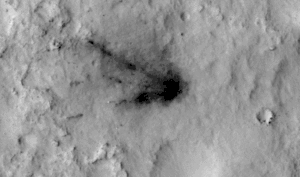
On April 4, 2015, NASA reported studies, based on measurements by the Sample Analysis at Mars (SAM) instrument on the Curiosity rover, of the Martian atmosphere using xenon and argon isotopes. Results provided support for a "vigorous" loss of atmosphere early in the history of Mars and were consistent with an atmospheric signature found in bits of atmosphere captured in some Martian meteorites found on Earth.[170]
On August 19, 2015, NASA scientists reported that the Dynamic Albedo of Neutrons (DAN) instrument on the Curiosity rover detected an unusual hydrogen-rich area, at "Marias Pass," on Mars. The hydrogen found seemed related to water or hydroxyl ions in rocks within three feet beneath the rover, according to the scientists.[171]

On October 5, 2015, possible recurrent slope lineae, wet brine flows, were reported on Mount Sharp near Curiosity.[172] In addition, on October 5, 2015, NASA reported an estimated 20,000 to 40,000 heat-resistant bacterial spores were on Curiosity at launch, as much as 1,000 times more than that may not have been counted.[172]
On October 8, 2015, NASA confirmed that lakes and streams existed in Gale crater 3.3 - 3.8 billion years ago delivering sediments to build up the lower layers of Mount Sharp.[173][174]

(Curiosity rover; December 17, 2015).
On December 17, 2015, NASA reported that as Curiosity climbed higher up Mount Sharp, the composition of rocks were changing substantially. For example, rocks found higher up the mountain contained much higher levels of silica than the basaltic rocks found earlier. After further analysis, the silica-rich rocks on Mars were found to be tridymite, a mineral that is not commonly found on Earth. Opal-A, another form of silica, was also found on Mars.[175]
2016 events
As of October 3, 2016, NASA summarized the findings of the mission, thus far, as follows: "The Curiosity mission has already achieved its main goal of determining whether the landing region ever offered environmental conditions that would have been favorable for microbial life, if Mars has ever hosted life. The mission found evidence of ancient rivers and lakes, with a chemical energy source and all of the chemical ingredients necessary for life as we know it."[176] Plans for the next two years, up to September 2018, include further explorations of the uphill slopes of Mount Sharp, including a ridge rich in the mineral hematite and a region of clay-rich bedrock.[176]
On December 13, 2016, NASA reported further evidence supporting habitability on Mars as the Curiosity rover climbed higher, studying younger layers, on Mount Sharp.[178] Also reported, the very soluble element boron was detected for the first time on Mars.[178] Since landing on Mars in August 2012, Curiosity has driven 15.0 km (9.3 mi) and climbed 165 m (541 ft) in elevation.[179]
%252C_Figure_1.jpg.webp)


2017 events
On January 17, 2017, NASA released an image of a rock slab, named "Old Soaker", which may contain mud cracks. Also, somewhat later, it released an animation of sand moving in a nearby area.
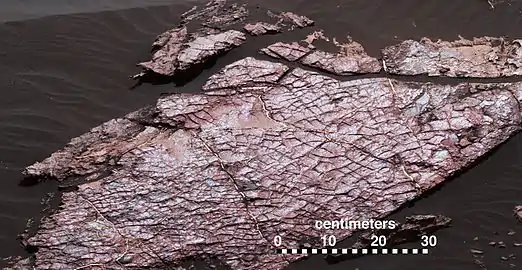 Rock slab, named "Old Soaker", which may contain mud cracks – as viewed by Curiosity (December 20, 2016).
Rock slab, named "Old Soaker", which may contain mud cracks – as viewed by Curiosity (December 20, 2016). Sand moving on Mars – as viewed by Curiosity (January 23, 2017).
Sand moving on Mars – as viewed by Curiosity (January 23, 2017).
On February 6, 2017, NASA reported that rock samples analyzed by the rover have not revealed any significant carbonate. This poses a puzzle to researchers: the same rocks that indicate a lake existed also indicate there was very little carbon dioxide in the air to help keep the lake unfrozen.[181]
On February 27, 2017, NASA presented the following mission overview: "During the first year after Curiosity's 2012 landing in Gale Crater, the mission fulfilled its main goal by finding that the region once offered environmental conditions favorable for microbial life. The conditions in long-lived ancient freshwater Martian lake environments included all of the key chemical elements needed for life as we know it, plus a chemical source of energy that is used by many microbes on Earth. The extended mission is investigating how and when the habitable ancient conditions evolved into conditions drier and less favorable for life."[182]
On June 1, 2017, NASA reported that the Curiosity rover provided evidence of an ancient lake in Gale crater on Mars that could have been favorable for microbial life; the ancient lake was stratified, with shallows rich in oxidants and depths poor in oxidants; and, the ancient lake provided many different types of microbe-friendly environments at the same time. NASA further reported that the Curiosity rover will continue to explore higher and younger layers of Mount Sharp in order to determine how the lake environment in ancient times on Mars became the drier environment in more modern times.[183][184][185]

Between July 22 and August 1, 2017, few commands were sent from the Earth to Mars since Mars was in conjunction with the sun.[187]
On August 5, 2017, NASA celebrated the fifth anniversary of the Curiosity rover mission landing, and related exploratory accomplishments, on the planet Mars.[188][189] (Videos: Curiosity's First Five Years (02:07); Curiosity's POV: Five Years Driving (05:49); Curiosity's Discoveries About Gale Crater (02:54))
On September 5, 2017, scientists reported that the Curiosity rover detected boron, an essential ingredient for life on Earth, on the planet Mars. Such a finding, along with previous discoveries that water may have been present on ancient Mars, further supports the possible early habitability of Gale Crater on Mars.[190][191]

On September 13, 2017, NASA reported that the Curiosity rover climbed an iron-oxide-bearing ridge called Vera Rubin Ridge (or Hematite Ridge) and will now start studying the numerous bright veins embedded in the various layers of the ridge, in order to provide more details about the history and habitability of ancient Mars.[192]
On September 30, 2017, NASA reported radiation levels on the surface of the planet Mars were temporarily doubled, and were associated with an aurora 25-times brighter than any observed earlier, due to a massive, and unexpected, solar storm in the middle of the month.[193]

On October 17, 2017, NASA announced the testing of its systems on Curiosity in an attempt to better resume drilling. The drilling system had stopped working reliably in December 2016.[194]

2018 events
On January 2, 2018, Curiosity captured images of rock shapes that may require further study in order to help better determine whether the shapes are biological or geological.[195][196]

On March 22, 2018, Curiosity had spent 2000 sols (2054 days) on Mars,[197] and prepares to study a region of clay-bearing rocks.

In June 2018, a local dust storm occurred near the Opportunity rover which may affect Curiosity.[198][199] The first signs of the storm, 1,000 km (620 mi) from Opportunity, were discovered on June 1, 2018 in photographs by the Mars Color Imager (MARCI) camera on the Mars Reconnaissance Orbiter (MRO). More weather reports from the MRO and the MARCI team indicated a prolonged storm. Although this was, at that time, still far away from the rover, it influenced the atmospheric permeability (opacity) at the location. Within days, the storm had spread. As of June 12, 2018, the storm spanned an area of 41 million km2 (16 million sq mi) - about the area of North America and Russia combined.[198][200] Although such dust storms are not surprising, they rarely occur. They can arise within a short time and then persist for weeks to months. During the southern season of summer, the sunlight heats dust particles and brings them higher into the atmosphere. This creates wind, which in turn stirs up more dust. This results in a feedback loop that scientists are still trying to understand. NASA reported on June 20, 2018 that the dust storm had grown to completely cover the entire planet.[201][202]
 Mars (before/after) dust storm (July 2018)
Mars (before/after) dust storm (July 2018)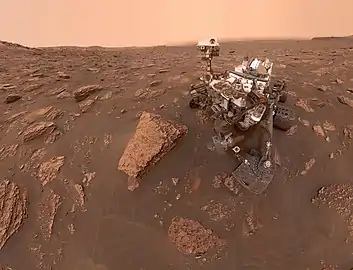
On June 4, 2018, NASA announced that Curiosity's ability to drill has been sufficiently restored by engineers. The rover had experienced drill mechanical problems since December 2016.[203]
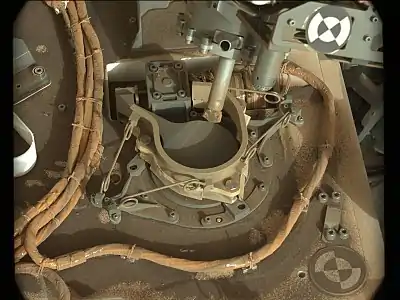
(May 31, 2018/Sol 2068)[203]
On June 7, 2018, NASA announced a cyclical seasonal variation in atmospheric methane, as well as the presence of kerogen and other complex organic compounds. The organic compounds were from mudstone rocks aged approximately 3.5 billion years old, sampled from two distinct sites in a dry lake in the Pahrump Hills of the Gale crater. The rock samples, when pyrolyzed via the Curiosity's Sample Analysis at Mars instrument, released an array of organic molecules; these include sulfur-containing thiophenes, aromatic compounds such as benzene and toluene, and aliphatic compounds such as propane and butene. The concentration of organic compounds are 100-fold higher than earlier measurements. The authors speculate that the presence of sulfur may have helped preserve them. The products resemble those obtained from the breakdown of kerogen, a precursor to oil and natural gas on Earth. NASA stated that these findings are not evidence that life existed on the planet, but that the organic compounds needed to sustain microscopic life were present, and that there may be deeper sources of organic compounds on the planet.[204][205][206][207][208][209][210][211]


Since September 15, 2018, a glitch in Curiosity's active computer (Side-B) has prevented Curiosity from storing science and key engineering data.[213] On October 3, 2018, the JPL began operating Curiosity on its backup computer (Side-A).[213] Curiosity will store science and engineering data normally using its Side-A computer until the cause of the glitch in Side-B is determined and remedied.[213]


On November 4, 2018, geologists presented evidence, based on studies in Gale Crater by the Curiosity rover, that there was plenty of water on early Mars.[215][216]

On November 26, 2018, Curiosity viewed a shiny object (named, "Little Colonsay") on Mars.[217] Although possibly a meteorite, further studies are planned to better understand its nature.
2019 events
On February 1, 2019, NASA scientists reported that the Mars Curiosity rover determined, for the first time, the density of Mount Sharp in Gale crater, thereby establishing a clearer understanding of how the mountain was formed.[218][219]
On April 4, 2019, NASA released images of solar eclipses by the two moons of the planet Mars, Phobos (animation1) and Deimos (animation2), as viewed by the Curiosity rover on the planet Mars in March 2019.[220][221]
On April 11, 2019, NASA announced that the Curiosity rover on the planet Mars drilled into, and closely studied, a "clay-bearing unit" which, according to the rover Project Manager, is a "major milestone" in Curiosity's journey up Mount Sharp.[222]



During June 2019, while still studying the clay-bearing unit, Curiosity detected the highest levels of methane gas, 21 parts per billion, compared to the typical 1 part per billion the rover detects as normal background readings. The levels of methane dropped quickly over a few days, leading NASA to call this event one of several methane plumes that they have observed before but without any observable pattern. The rover lacked the necessary instrumentation to determine if the methane was biological or inorganic in nature.[223][224][225]



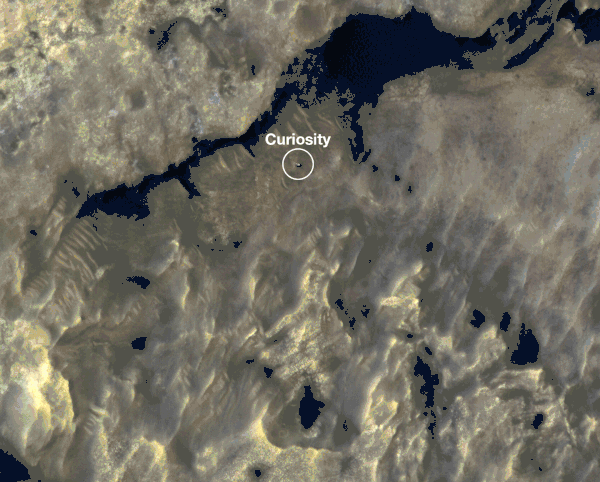
In October 2019, evidence, uncovered by the Curiosity rover on Mount Sharp, was reported of a 150 km (93 mi) wide ancient basin in Gale crater that once may have contained a salty lake.[226][227]
2020 events

In January 2020, a report was presented that compared Curiosity at the time of its landing on Mars in 2012, with the rover over seven years later in 2020.[228]
In February 2020, scientists reported the detection of thiophene organic molecules by the Curiosity rover on the planet Mars. It is not currently known if the detected thiophenes — usually associated on Earth with kerogen, coal and crude oil — are the result of biological or non-biological processes.[229][230]
In April 2020, scientists began operating the rover remotely from their homes due to the COVID-19 pandemic.[231]




On 29 August 2020, NASA released several videos taken by the Curiosity rover, including those involving dust devils, as well as very high resolution images of the related local martian terrain.[232]

Current status
Weather
- Current Weather Report on Mars by the Curiosity rover
- Current Weather Report on Mars by the InSight lander[233][234]
Location and travel statistics
As of January 27, 2021, Curiosity has been on the planet Mars for 3014 sols (3096 total days) since landing on August 6, 2012. Since September 11, 2014, Curiosity has been exploring the slopes of Mount Sharp,[150][151] where more information about the history of Mars is expected to be found.[110] As of January 26, 2021, the rover has traveled over 24.15 km (15.01 mi) and climbed over 327 m (1,073 ft) in elevation[152][179][235] to, and around, the mountain base since landing at "Bradbury Landing" in August 2012.[152][179]

(February 18, 2014/Sol 547).
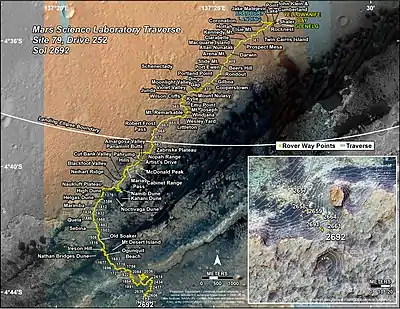
(March 3, 2020/Sol 2692).
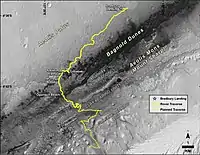
Equipment status
Since early 2015, the percussive mechanism in the drill that helps chisels into rock has had an intermittent electrical short circuit.[236]
In December 2016, the motor inside the drill caused a malfunction that prevented the rover from moving its robotic arm and driving to another location.[237] The fault is in the drill feed motor - internal debris is suspected.[236] The fault was determined to be limited to the drill mechanism and the rover started moving again on December 9. The robotic arm is functional, and the Curiosity team performed diagnostics on the drill mechanism throughout 2017.[238] On June 4, 2018, NASA announced that Curiosity's ability to drill has been sufficiently restored by changing the drilling methods.[203]
Since September 15, 2018, a glitch in Curiosity's active computer (Side-B) has prevented Curiosity from storing science and key engineering data.[213] On October 3, 2018, the JPL began operating Curiosity on its backup computer (Side-A).[213] Curiosity will store science and engineering data normally using its Side-A computer until the cause of the glitch in Side-B is determined and remedied.[213]
Images
Self-portraits

Videos
(August 2, 2013).[108][109]
(August 1, 2013).[108][109]
(August 20, 2013).
Gallery
 First-Year and First-Mile Traverse Map of the Curiosity rover on Mars (August 1, 2013; 3-D).
First-Year and First-Mile Traverse Map of the Curiosity rover on Mars (August 1, 2013; 3-D). Gale crater - surface materials (false colors; THEMIS; 2001 Mars Odyssey).
Gale crater - surface materials (false colors; THEMIS; 2001 Mars Odyssey). Curiosity rover - diagram noting "3-sigma safe-to-land ellipse".
Curiosity rover - diagram noting "3-sigma safe-to-land ellipse".
 Curiosity rover - image noting "3-sigma safe-to-land ellipse".
Curiosity rover - image noting "3-sigma safe-to-land ellipse". Curiosity viewed from space crosses edge of its "3-sigma safe-to-land ellipse" (June 27, 2014).
Curiosity viewed from space crosses edge of its "3-sigma safe-to-land ellipse" (June 27, 2014).
 Base of Aeolis Mons, an area of varied terran that Curiosity is expected to study.[239]
Base of Aeolis Mons, an area of varied terran that Curiosity is expected to study.[239] Layers at the base of Aeolis Mons - dark rock in inset is same size as the Curiosity rover.
Layers at the base of Aeolis Mons - dark rock in inset is same size as the Curiosity rover.

 First laser spectrum of chemical elements on the Coronation rock (August 19, 2012).
First laser spectrum of chemical elements on the Coronation rock (August 19, 2012).

 Curiosity's view of the Mars moons: Phobos passes Deimos - in real-time (August 1, 2013; video-gif).
Curiosity's view of the Mars moons: Phobos passes Deimos - in real-time (August 1, 2013; video-gif).
 Curiosity's SW view near Darwin Outcrop (lower-center) (Waypoint 1; September 7, 2013).
Curiosity's SW view near Darwin Outcrop (lower-center) (Waypoint 1; September 7, 2013). Curiosity's view of tracks while crossing the Dingo Gap sand dune (February 6, 2014; video-gif).
Curiosity's view of tracks while crossing the Dingo Gap sand dune (February 6, 2014; video-gif).
 Curiosity's view after crossing the Dingo Gap sand dune (February 10, 2014).
Curiosity's view after crossing the Dingo Gap sand dune (February 10, 2014). Curiosity's view of sandstone at different levels of erosion (February 25, 2014; raw color).
Curiosity's view of sandstone at different levels of erosion (February 25, 2014; raw color). Map of Curiosity's drive to The Kimberley Waypoint (KMS-9; April 2, 2014).
Map of Curiosity's drive to The Kimberley Waypoint (KMS-9; April 2, 2014). Curiosity's view of The Kimberley Waypoint (KMS-9; April 2, 2014; 3-D).
Curiosity's view of The Kimberley Waypoint (KMS-9; April 2, 2014; 3-D). Curiosity's view of a bright spot near "The Kimberley" (KMS-9; April 3, 2014).[240]
Curiosity's view of a bright spot near "The Kimberley" (KMS-9; April 3, 2014).[240]

 Map of Curiosity's drive to "Hidden Valley" (July 31, 2014).
Map of Curiosity's drive to "Hidden Valley" (July 31, 2014). Curiosity's tracks in the sands of "Hidden Valley" (August 4, 2014).
Curiosity's tracks in the sands of "Hidden Valley" (August 4, 2014).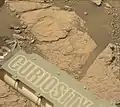 Curiosity near a lot of clay material in "Glen Torridon" (February 10, 2019).
Curiosity near a lot of clay material in "Glen Torridon" (February 10, 2019). Curiosity views "Ireson Hill" on Mount Sharp (February 2, 2017).
Curiosity views "Ireson Hill" on Mount Sharp (February 2, 2017). Comet C/2013 A1 during flyby of Mars (October 19, 2014).
Comet C/2013 A1 during flyby of Mars (October 19, 2014).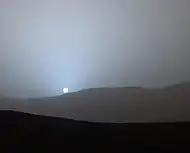 Sunset - Gale crater (April 15, 2015).
Sunset - Gale crater (April 15, 2015). Sunset (animated) - Gale crater (April 15, 2015).
Sunset (animated) - Gale crater (April 15, 2015).
Wide images

See also
- Aeolis quadrangle
- Astrobiology
- Composition of Mars
- ExoMars programme
- Exploration of Mars
- Geography of Mars
- Geology of Mars
- InSight lander
- List of missions to Mars
- List of rocks on Mars
- Mars Exploration Rover
- Mars Express orbiter
- Mars Odyssey Orbiter
- Mars Orbiter Mission
- Mars Pathfinder (Sojourner rover)
- Mars Reconnaissance Orbiter
- Mars 2020 rover mission
- MAVEN orbiter
- Moons of Mars
- Phoenix lander
- Robotic spacecraft
- Scientific information from the Mars Exploration Rover mission
- Space exploration
- U.S. Space Exploration History on U.S. Stamps
- Viking program
- Water on Mars
References
- Mars Science Laboratory's Cruise Stage in Test Chamber - NASA
- Stathopoulos, Vic (October 2011). "Mars Science Laboratory". Aerospace Guide. Retrieved February 4, 2012.
- INL, Teri Ehresman. "Mars Science Laboratory team accomplishes mission goal by working together". Idaho National Laboratory. Archived from the original on 2012-09-25. Retrieved 2012-08-12.
- "NASA Facts - MSL" (PDF). NASA. Retrieved 2012-08-13.
- 40th Lunar and Planetary Science Conference (2009); 41st Lunar and Planetary Science Conference (2010)
- Mars Science Laboratory: Still Alive, For Now. October 10, 2008. Universe Today.
- "Next NASA Mars Mission Rescheduled For 2011". NASA/JPL. December 4, 2008. Archived from the original on June 11, 2011. Retrieved December 4, 2008.
- Brown, Adrian (March 2, 2009). "Mars Science Laboratory: the budgetary reasons behind its delay: MSL: the budget story". The Space Review. Retrieved January 26, 2010.
NASA first put a reliable figure of the cost of the MSL mission at the "Phase A/Phase B transition", after a preliminary design review (PDR) that approved instruments, design and engineering of the whole mission. That was in August 2006—and the Congress-approved figure was $1.63 billion. … With this request, the MSL budget had reached $1.9 billion. … NASA HQ requested JPL prepare an assessment of costs to complete the construction of MSL by the next launch opportunity (in October 2011). This figure came in around $300 million, and NASA HQ has estimated this will translate to at least $400 million (assuming reserves will be required), to launch MSL and operate it on the surface of Mars from 2012 through 2014.
- "Audit Report: NASA'S MANAGEMENT OF THE MARS SCIENCE LABORATORY PROJECT" (PDF). OFFICE OF INSPECTOR GENERAL. NASA. 8 June 2011. Retrieved 2012-08-13.
REPORT NO. IG-11-019
- Mars rover name
- "Name NASA's Next Mars Rover". NASA/JPL. May 27, 2009. Archived from the original on February 20, 2012. Retrieved May 27, 2009.
- "MSL Landing Site Selection User's Guide to Engineering Constraints" (PDF). June 12, 2006. Retrieved May 29, 2007.
- "Second MSL Landing Site Workshop".
- "MSL Workshop Voting Chart" (PDF). September 18, 2008.
- GuyMac (January 4, 2008). "Reconnaissance of MSL Sites". HiBlog. Retrieved October 21, 2008.
- "Mars Exploration Science Monthly Newsletter" (PDF). August 1, 2008. Archived from the original (PDF) on July 21, 2011.
- "Site List Narrows For NASA's Next Mars Landing". MarsToday. November 19, 2008. Archived from the original on November 27, 2008. Retrieved April 21, 2009.
- "Current MSL Landing Sites". NASA. Archived from the original on March 15, 2012. Retrieved January 4, 2010.
- "Looking at Landing Sites for the Mars Science Laboratory". YouTube. NASA/JPL. May 27, 2009. Retrieved May 28, 2009.
- "Final 7 Prospective Landing Sites". NASA. February 19, 2009. Retrieved February 9, 2009.
- "Mars Science Laboratory: Possible MSL Landing Site: Eberswalde Crater". Archived from the original on 2012-01-27. Retrieved 2012-08-28.
- "Mars Science Laboratory: Possible MSL Landing Site: Holden Crater". Archived from the original on 2012-04-30. Retrieved 2012-08-28.
- "Mars Science Laboratory: Possible MSL Landing Site: Gale Crater". Archived from the original on 2012-01-17. Retrieved 2012-08-28.
- Amos, Jonathan (July 22, 2011). "Mars rover aims for deep crater". BBC News. Retrieved July 22, 2011.
- "Mars Science Laboratory: Possible MSL Landing Site: Mawrth Vallis". Archived from the original on 2012-08-28. Retrieved 2012-08-28.
- Presentations for the Fourth MSL Landing Site Workshop September 2010
- Second Announcement for the Final MSL Landing Site Workshop and Call for Papers Archived 2012-09-08 at Archive.today March 2011
- Amos, Jonathan (June 12, 2012). "Nasa's Curiosity rover targets smaller landing zone". BBC News. Retrieved June 12, 2012.
- "NASA - Multimedia - Video Gallery". Nasa.gov. 2010-04-28. Retrieved 2012-08-10.
- "United Launch Alliance Atlas V Rocket Successfully Launches NASA's Mars Science Lab on Journey to Red Planet". ULA Launch Information. United Launch Alliance. 2011-11-26. Archived from the original on 2013-12-07. Retrieved 2012-08-19.
- MSL cruise configuration
- Assembling Curiosity's Rocket to Mars.
- Sutton, Jane (November 3, 2011). "NASA's new Mars rover reaches Florida launch pad". Reuters.
- Brown, Dwayne (December 13, 2011). "NASA Mars-Bound Rover Begins Research in Space". NASA. Retrieved 21 August 2012.
- Beutel, Allard (November 19, 2011). "NASA's Mars Science Laboratory Launch Rescheduled for Nov. 26". NASA. Retrieved November 21, 2011.
- "Status Report - Curiosity's Daily Update". NASA. August 6, 2012. Archived from the original on September 16, 2016. Retrieved August 13, 2012.
This morning, flight controllers decided to forgo the sixth and final opportunity on the mission calendar for a course-correction maneuver.
- "Mars Rover 'Mohawk Guy' a Space Age Internet Sensation | Curiosity Rover". Space.com. Retrieved 2012-08-08.
- Wall, Mike (August 6, 2012). "Touchdown! Huge NASA Rover Lands on Mars". Space.com. Retrieved December 14, 2012.
- "Curiosity: NASA's Next Mars Rover". NASA. August 6, 2012. Retrieved August 6, 2012.
- "MSL Sol 3 Update". NASA Television. August 8, 2012. Retrieved August 9, 2012.
- "MSL Mission Updates". Spaceflight101.com. 6 August 2012. Archived from the original on 25 August 2012.
- NASA. "MSL - Cruise Configuration". JPL. Retrieved 2012-08-08.
- Dahya, N. (1–8 March 2008). "Design and Fabrication of the Cruise Stage Spacecraft for MSL". 2008 IEEE Aerospace Conference. Aerospace Conference, 2008 IEEE. IEEE Explore. pp. 1–6. doi:10.1109/AERO.2008.4526539. ISBN 978-1-4244-1487-1. S2CID 21599522.
- "Follow Curiosity's descent to Mars". NASA. 2012. Archived from the original on 2012-08-21. Retrieved 2012-08-23.
Animation
- Amos, Jonathan (11 August 2012). "Curiosity rover made near-perfect landing". BBC News. Retrieved 2012-08-14.
- MSNBC Staff (August 6, 2012). "Video from rover looks down on Mars during landing". NBC News. Retrieved October 7, 2012.
- Young, Monica (August 7, 2012). "Watch Curiosity Descend onto Mars". SkyandTelescope.com. Archived from the original on December 9, 2012. Retrieved October 7, 2012.
- "Mars Rover Beams Back Images Showing Its Descent". NASA. 6 August 2012. Retrieved 2012-08-15.
- The Curiosity Rover Preps for Big Plans After its Daring Descent Time. August 9, 2012
- M. Wall - Mars rover survives 'brain transplant' with flying colors - NBC
- "Curiosity's Descent".
- Mars Science Laboratory: Multimedia-Images
- Mars Science Laboratory: Multimedia-Images
- Mars Science Laboratory: Multimedia-Images
- Mars Science Laboratory: Raw Images
- Mars Science Laboratory: Raw Images
- Harwood, William (August 14, 2012). "Rover software updated, first driving tests on tap". C-Net News. Retrieved 2012-08-15.
- First drive
- Webster, Guy; Agle, D.C. (August 19, 2012). "Mars Science Laboratory/Curiosity Mission Status Report". NASA. Retrieved September 3, 2012.
- Staff. "'Coronation' Rock on Mars". NASA. Retrieved September 3, 2012.
- Amos, Jonathan (August 17, 2012). "Nasa's Curiosity rover prepares to zap Martian rocks". BBC News. Retrieved September 3, 2012.
- "Mars rover could start moving in a week". CNN News. 15 August 2012. Retrieved 2012-08-15.
- "How Does ChemCam Work?". ChemCam Team. 2011. Retrieved 2012-08-20.
- Brown, Dwayne (August 29, 2012). "NASA Curiosity Rover Begins Eastbound Trek on Martian Surface". JPL. Retrieved 2012-08-30.
- Zakutnyaya, Olga (August 21, 2012). "Curiosity expected to boost Martian science worldwide". The Voice of Russia. Archived from the original on August 23, 2012. Retrieved August 21, 2012.
- Doyle, Kathryn (2012). "Curiosity Ready to Blast Rocks and Study Moons". Popular Mechanics. Retrieved 2012-09-19.
- Boyle, Alan (19 September 2012). "Mars rover targets a rock called Jake". Cosmic Log on NBC News. Retrieved 2012-09-19.
- Amos, Jonathan (October 17, 2012). "Cosmic coincidence on the road to Glenelg". BBC News. Retrieved October 17, 2012.
- Wall, Mike (October 4, 2012). "Curiosity Rover to Scoop Up 1st Mars Samples This Weekend". Space.com. Retrieved October 5, 2012.
- Brown, Dwayne; Cole, Steve; Webster, Guy; Agle, D.C. (September 27, 2012). "NASA Rover Finds Old Streambed On Martian Surface". NASA. Retrieved September 28, 2012.
- NASA (September 27, 2012). "NASA's Curiosity Rover Finds Old Streambed on Mars - video (51:40)". NASAtelevision. Retrieved September 28, 2012.
- Chang, Alicia (September 27, 2012). "Mars rover Curiosity finds signs of ancient stream". AP News. Retrieved September 27, 2012.
- Wall, Mike (October 18, 2012). "Yum! Curiosity Rover Swallows 1st Mars Sample, Finds Odd Bright Stuff". Space.com. Retrieved October 19, 2012.
- Staff (October 15, 2012). "Small Debris on the Ground Beside Curiosity". NASA. Retrieved October 15, 2012.
- Major, Jason (October 9, 2012). "Curiosity Finds…SOMETHING…on Martian Surface". UniverseToday. Retrieved October 9, 2012.
- Staff (October 18, 2012). "Bright Particle in Hole Dug by Scooping of Martian Soil". NASA. Retrieved October 18, 2012.
- Staff (October 15, 2012). "Bright Particle of Martian Origin in Scoop Hole". NASA. Retrieved October 15, 2012.
- Brown, Dwayne (October 30, 2012). "NASA Rover's First Soil Studies Help Fingerprint Martian Minerals". NASA. Retrieved October 31, 2012.
- Staff (November 22, 2012). "Thanksgiving on Mars: Working Holiday for Curiosity Rover". Space.com. Retrieved November 22, 2012.
- Brown, Dwayne; Webster, Guy; Neal-Jones, Nancy (December 3, 2012). "NASA Mars Rover Fully Analyzes First Martian Soil Samples". NASA. Archived from the original on August 23, 2016. Retrieved December 3, 2012.
- Chang, Ken (December 3, 2012). "Mars Rover Discovery Revealed". New York Times. Retrieved December 3, 2012.
- NASA Curiosity Rover Collects First Martian Bedrock Sample
- Anderson, Paul Scott (February 3, 2013). "Curiosity 'hammers' a rock and completes first drilling tests". themeridianijournal.com. Archived from the original on February 6, 2013. Retrieved February 3, 2013.
- Agle, DC; Brown, Dwayne (March 12, 2013). "NASA Rover Finds Conditions Once Suited for Ancient Life on Mars". NASA. Retrieved March 12, 2013.
- Wall, Mike (March 12, 2013). "Mars Could Once Have Supported Life: What You Need to Know". Space.com. Retrieved March 12, 2013.
- Chang, Kenneth (March 12, 2013). "Mars Could Once Have Supported Life, NASA Says". New York Times. Retrieved March 12, 2013.
- Harwood, William (March 12, 2013). "Mars rover finds habitable environment in distant past". Spaceflightnow. Retrieved March 12, 2013.
- Grenoble, Ryan (March 12, 2013). "Life On Mars Evidence? NASA's Curiosity Rover Finds Essential Ingredients In Ancient Rock Sample". Huffington Post. Retrieved March 12, 2013.
- Nora, Noffke (February 14, 2015). "Ancient Sedimentary Structures in the <3.7 Ga Gillespie Lake Member, Mars, That Resemble Macroscopic Morphology, Spatial Associations, and Temporal Succession in Terrestrial Microbialites". Astrobiology. 15 (2): 169–192. Bibcode:2015AsBio..15..169N. doi:10.1089/ast.2014.1218. PMID 25495393.
- Webster, Guy (April 8, 2013). "Remaining Martian Atmosphere Still Dynamic". NASA. Archived from the original on February 13, 2017. Retrieved April 9, 2013.
- Wall, Mike (April 8, 2013). "Most of Mars' Atmosphere Is Lost in Space". Space.com. Retrieved April 9, 2013.
- Mann, Adam (July 18, 2013). "Mars Rover Finds Good News for Past Life, Bad News for Current Life on Mars". Wired. Retrieved July 19, 2013.
- Webster Chris R.; et al. (July 19, 2013). "Isotope Ratios of H, C, and O in CO2 and H2O of the Martian Atmosphere" (PDF). Science. 341 (6143): 260–263. Bibcode:2013Sci...341..260W. doi:10.1126/science.1237961. PMID 23869013. S2CID 206548962.
- Mahaffy, Paul R.; et al. (July 19, 2013). "Abundance and Isotopic Composition of Gases in the Martian Atmosphere from the Curiosity Rover". Science. 341 (6143): 263–266. Bibcode:2013Sci...341..263M. doi:10.1126/science.1237966. PMID 23869014. S2CID 206548973.
- Webster, Guy (18 March 2013). "New 'Safe Mode' Status of Curiosity Expected to be Brief - Mission Status Report - 03.18.13". NASA. Retrieved 19 March 2013.
- Fountain, Henry (March 19, 2013). "Mars Rover Is Repaired, NASA Says". New York Times. Retrieved March 19, 2013.
- Webster, Guy; Brown, Dwayne (March 18, 2013). "Curiosity Mars Rover Sees Trend In Water Presence". NASA. Archived from the original on April 19, 2013. Retrieved March 20, 2013.
- Rincon, Paul (March 19, 2013). "Curiosity breaks rock to reveal dazzling white interior". BBC. Retrieved March 19, 2013.
- Staff (March 20, 2013). "Red planet coughs up a white rock, and scientists freak out". MSN. Archived from the original on March 23, 2013. Retrieved March 20, 2013.
- Wall, Mike (April 4, 2013). "Curiosity Rover Goes Solo on Mars for 1st Time Today". Space.com. Retrieved April 9, 2013.
- Staff (June 5, 2013). "From 'Glenelg' to Mount Sharp". NASA. Retrieved June 6, 2013.
- Chang, Alicia (June 5, 2013). "Curiosity rover to head toward Mars mountain soon". AP News. Retrieved June 7, 2013.
- Chang, Kenneth (June 7, 2013). "Martian Rock Another Clue to a Once Water-Rich Planet". New York Times. Retrieved June 7, 2013.
- Staff (16 July 2013). "One Down, Many Kilometers to Go". NASA. Retrieved 19 July 2013.
- Staff (August 2, 2013). "PIA17085: Full Curiosity Traverse Passes One-Mile Mark". NASA. Retrieved August 2, 2013.
- Dewey, Caitlin (August 6, 2013). "Lonely Curiosity rover sings 'Happy Birthday' to itself on Mars". Washington Post. Retrieved August 7, 2013.
- Koren, Marina (August 10, 2017). "Why the Curiosity Rover Stopped Singing 'Happy Birthday' to Itself". The Atlantic. Retrieved August 11, 2017.
- Chang, Kenneth (August 5, 2013). "An Earth Year on Mars". New York Times. Retrieved August 5, 2013.
- Corum, Jonathan; White, Jeremy (August 5, 2013). "Mars Curiosity Rover Tracker - Front-Page Interactive Feature". New York Times. Retrieved August 5, 2013.
- Webster, Guy (August 6, 2013). "Mars Curiosity Landing: Relive the Excitement". NASA. Archived from the original on September 11, 2013. Retrieved August 7, 2013.
- Webster, Guy (August 27, 2013). "NASA's Mars Curiosity Debuts Autonomous Navigation". NASA. Archived from the original on October 28, 2016. Retrieved August 27, 2013.
- Webster, Christopher R.; Mahaffy, Paul R.; Atreya, Sushil K.; Flesch, Gregory J.; Farley, Kenneth A.; Kemppinen, O.; Bridges, N.; Johnson, J. R.; Minitti, M.; Cremers, D.; Bell, J. F.; Edgar, L.; Farmer, J.; Godber, A.; Wadhwa, M.; Wellington, D.; McEwan, I.; Newman, C.; Richardson, M.; Charpentier, A.; Peret, L.; King, P.; Blank, J.; Weigle, G.; Schmidt, M.; Li, S.; Milliken, R.; Robertson, K.; Sun, V.; et al. (September 19, 2013). "Low Upper Limit to Methane Abundance on Mars". Science. 342 (6156): 355–357. Bibcode:2013Sci...342..355W. doi:10.1126/science.1242902. PMID 24051245. S2CID 43194305. Retrieved September 19, 2013.
- Cho, Adrian (September 19, 2013). "Mars Rover Finds No Evidence of Burps and Farts". Science. Retrieved September 19, 2013.
- Chang, Kenneth (September 19, 2013). "Mars Rover Comes Up Empty in Search for Methane". New York Times. Retrieved September 19, 2013.
- Lieberman, Josh (September 26, 2013). "Mars Water Found: Curiosity Rover Uncovers 'Abundant, Easily Accessible' Water In Martian Soil". iSciencetimes. Archived from the original on June 23, 2017. Retrieved September 26, 2013.
- Leshin, L. A; et al. (September 27, 2013). "Volatile, Isotope, and Organic Analysis of Martian Fines with the Mars Curiosity Rover". Science. 341 (6153): 1238937. Bibcode:2013Sci...341E...3L. CiteSeerX 10.1.1.397.4959. doi:10.1126/science.1238937. PMID 24072926. S2CID 206549244.
- Grotzinger, John (September 26, 2013). "Introduction To Special Issue: Analysis of Surface Materials by the Curiosity Mars Rover". Science. 341 (6153): 1475. Bibcode:2013Sci...341.1475G. doi:10.1126/science.1244258. PMID 24072916. Retrieved September 27, 2013.
- Neal-Jones, Nancy; Zubritsky, Elizabeth; Webster, Guy; Martialay, Mary (September 26, 2013). "Curiosity's SAM Instrument Finds Water and More in Surface Sample". NASA. Retrieved September 27, 2013.
- Webster, Guy; Brown, Dwayne (September 26, 2013). "Science Gains From Diverse Landing Area of Curiosity". NASA. Retrieved September 27, 2013.
- Chang, Kenneth (October 1, 2013). "Hitting Pay Dirt on Mars". New York Times. Retrieved October 2, 2013.
- Meslin, P.-Y.; et al. (September 26, 2013). "Soil Diversity and Hydration as Observed by ChemCam at Gale Crater, Mars". Science. 341 (6153): 1238670. Bibcode:2013Sci...341E...1M. CiteSeerX 10.1.1.397.5426. doi:10.1126/science.1238670. PMID 24072924. S2CID 7418294. Retrieved September 27, 2013.
- Stolper, E.M.; Baker, M.B.; Newcombe, M.E.; Schmidt, M.E.; Treiman, A.H.; Cousin, A.; Dyar, M.D.; Fisk, M.R.; Gellert, R.; King, P.L.; Leshin, L.; Maurice, S.; McLennan, S.M.; Minitti, M.E.; Perrett, G.; Rowland, S.; Sautter, V.; Wiens, R.C.; MSL ScienceTeam, O.; Bridges, N.; Johnson, J. R.; Cremers, D.; Bell, J. F.; Edgar, L.; Farmer, J.; Godber, A.; Wadhwa, M.; Wellington, D.; McEwan, I.; et al. (2013). "The Petrochemistry of Jake_M: A Martian Mugearite" (PDF). Science. 341 (6153): 1239463. Bibcode:2013Sci...341E...4S. doi:10.1126/science.1239463. PMID 24072927. S2CID 16515295.
- Webster, Guy (October 17, 2013). "NASA Rover Confirms Mars Origin of Some Meteorites". NASA. Archived from the original on November 15, 2013. Retrieved October 29, 2013.
- Webster, Guy; Brown, Dwayne (November 13, 2013). "Mars Rover Teams Dub Sites In Memory of Bruce Murray". NASA. Retrieved November 14, 2013.
- Webster, Guy (November 20, 2013). "Rover Team Working to Diagnose Electrical Issue". NASA. Retrieved November 21, 2013.
- Staff (November 25, 2013). "Curiosity Resumes Science After Analysis of Voltage Issue". NASA. Retrieved November 25, 2013.
- Grotzinger, John (November 26, 2013). "The World of Mars". New York Times. Retrieved November 27, 2013.
- Chang, Kenneth (December 9, 2013). "On Mars, an Ancient Lake and Perhaps Life". New York Times. Retrieved December 9, 2013.
- Various (December 9, 2013). "Science - Special Collection - Curiosity Rover on Mars". Science. Retrieved December 9, 2013.
- Blake, D. F.; et al. (2013). "Curiosity at Gale crater, Mars: characterization and analysis of the Rocknest sand shadow" (PDF). Science. 341 (6153): 1239505. Bibcode:2013Sci...341E...5B. doi:10.1126/science.1239505. PMID 24072928. S2CID 14060123.
- Leshin, L. A.; et al. (2013). "Volatile, isotope, and organic analysis of Martian fines with the Mars Curiosity rover". Science. 341 (6153): 1238937. Bibcode:2013Sci...341E...3L. CiteSeerX 10.1.1.397.4959. doi:10.1126/science.1238937. PMID 24072926. S2CID 206549244.
- McLennan, S. M.; et al. (2013). "Elemental geochemistry of sedimentary rocks at Yellowknife Bay, Gale Crater, Mars" (PDF). Science. 343 (6169): 1244734. Bibcode:2014Sci...343.....M. doi:10.1126/science.1244734. hdl:2381/42019. PMID 24324274. S2CID 36866122.
- Flynn, George J. (1996). "The delivery of organic matter from asteroids and comets to the early surface of Mars". Earth Moon Planets. 72 (1–3): 469–474. Bibcode:1996EM&P...72..469F. doi:10.1007/BF00117551. PMID 11539472. S2CID 189901503.
- Benner, S. A.; Devine, K. G.; Matveeva, L. N.; Powell, D. H. (2000). "The missing organic molecules on Mars". Proc. Natl. Acad. Sci. U.S.A. 97 (6): 2425–2430. Bibcode:2000PNAS...97.2425B. doi:10.1073/pnas.040539497. PMC 15945. PMID 10706606.
- Grotzinger, J. P.; et al. (2013). "A Habitable Fluvio-Lacustrine Environment at Yellowknife Bay, Gale Crater, Mars". Science. 343 (6169): 1242777. Bibcode:2014Sci...343A.386G. CiteSeerX 10.1.1.455.3973. doi:10.1126/science.1242777. PMID 24324272. S2CID 52836398.
- Kerr, R. (2013). "New Results Send Mars Rover on a Quest for Ancient Life". Science. 342 (6164): 1300–1301. Bibcode:2013Sci...342.1300K. doi:10.1126/science.342.6164.1300. PMID 24337267.
- Ming, D. W.; et al. (2013). "Volatile and Organic Compositions of Sedimentary Rocks in Yellowknife Bay, Gale Crater, Mars" (PDF). Science. 343 (6169): 1245267. Bibcode:2014Sci...343E.386M. doi:10.1126/science.1245267. PMID 24324276. S2CID 10753737.
- Farley, K. A.; et al. (2013). "In Situ Radiometric and Exposure Age Dating of the Martian Surface". Science. 343 (6169): 1247166. Bibcode:2014Sci...343F.386H. doi:10.1126/science.1247166. PMID 24324273. S2CID 3207080.
- Staff (December 9, 2013). "Understanding Mars' Past and Current Environments". NASA. Retrieved December 20, 2013.
- Hassler, D. M.; et al. (2013). "Mars' Surface Radiation Environment Measured with the Mars Science Laboratory's Curiosity Rover" (PDF). Science. 343 (6169): 1244797. Bibcode:2014Sci...343D.386H. doi:10.1126/science.1244797. hdl:1874/309142. PMID 24324275. S2CID 33661472.
- Vaniman, D. T.; et al. (2013). "Mineralogy of a mudstone at Yellowknife Bay, Gale crater, Mars" (PDF). Science. 343 (6169): 1243480. Bibcode:2014Sci...343B.386V. doi:10.1126/science.1243480. PMID 24324271. S2CID 9699964.
- Bibring, J. P.; et al. (2006). "Global mineralogical and aqueous mars history derived from OMEGA/Mars Express data". Science. 312 (5772): 400–404. Bibcode:2006Sci...312..400B. doi:10.1126/science.1122659. PMID 16627738.
- Squyres, Steven W.; Knoll, Andrew H. (2005). "Sedimentary rocks and Meridiani Planum: Origin, diagenesis, and implications for life of Mars. Earth Planet". Sci. Lett. 240: 1–10. Bibcode:2005E&PSL.240....1S. doi:10.1016/j.epsl.2005.09.038.
- Nealson, K.; P. Conrad. (1999). "Life: past, present and future". Phil. Trans. R. Soc. Lond. B. 354 (1392): 1923–1939. doi:10.1098/rstb.1999.0532. PMC 1692713. PMID 10670014.
- Keller, Lindsay P.; et al. (1994). "Aqueous alteration of the Bali CV3 chondrite: Evidence from mineralogy, mineral chemistry, and oxygen isotopic compositions". Geochim. Cosmochim. Acta. 58 (24): 5589–5598. Bibcode:1994GeCoA..58.5589K. doi:10.1016/0016-7037(94)90252-6. PMID 11539152.
- Webster, Guy (December 20, 2013). "Curiosity Team Upgrades Software, Checks Wheel Wear - Mars Science Laboratory Mission Status Report". NASA. Retrieved December 23, 2013.
- Grotzinger, John P. (January 24, 2014). "Introduction to Special Issue - Habitability, Taphonomy, and the Search for Organic Carbon on Mars". Science. 343 (6169): 386–387. Bibcode:2014Sci...343..386G. doi:10.1126/science.1249944. PMID 24458635.
- Various (January 24, 2014). "Special Issue - Table of Contents - Exploring Martian Habitability". Science. 343 (6169): 345–452. Retrieved January 24, 2014.
- Various (January 24, 2014). "Special Collection - Curiosity - Exploring Martian Habitability". Science. Retrieved January 24, 2014.
- Webster, Guy; Agle, DC; Brown, Dwayne (September 11, 2014). "NASA's Mars Curiosity Rover Arrives at Martian Mountain". NASA. Retrieved September 10, 2014.
- Chang, Kenneth (September 11, 2014). "After a Two-Year Trek, NASA's Mars Rover Reaches Its Mountain Lab". New York Times. Retrieved September 12, 2014.
- Staff (January 19, 2017). "PIA17355: Curiosity's Progress on Route from 'Glenelg' to Mount Sharp". NASA. Retrieved January 22, 2017.
- Webster, Guy; Neal-Jones, Nancy; Brown, Dwayne (December 16, 2014). "NASA Rover Finds Active and Ancient Organic Chemistry on Mars". NASA. Retrieved December 16, 2014.
- Chang, Kenneth (December 16, 2014). "'A Great Moment': Rover Finds Clue That Mars May Harbor Life". New York Times. Retrieved December 16, 2014.
- Webster, Guy (January 29, 2014). "Mars Science Laboratory Mission Status Report". NASA. Retrieved February 8, 2014.
- Webster, Guy (February 6, 2014). "Through the Gap: Curiosity Mars Rover Crosses Dune". NASA. Retrieved February 8, 2014.
- Madhusoodanan, Jyoti (May 19, 2014). "Microbial stowaways to Mars identified". Nature. doi:10.1038/nature.2014.15249. S2CID 87409424. Retrieved May 23, 2014.
- Webster, Guy (June 10, 2014). "Mercury Passes in Front of the Sun, as Seen From Mars". NASA. Retrieved June 10, 2014.
- Webster, Guy; Brown, Dwayne (June 23, 2014). "NASA's Mars Curiosity Rover Marks First Martian Year". NASA. Retrieved June 23, 2014.
- Staff (July 8, 2014). "Curiosity Mars Rover Reaching Edge of Its Landing Ellipse". NASA. Retrieved July 11, 2014.
- Webster, Guy; Brown, Dwayne (August 5, 2014). "NASA Mars Curiosity Rover: Two Years and Counting on Red Planet". NASA. Retrieved August 6, 2014.
- Brown, Dwayne; Webster, Guy (December 8, 2014). "Release 14-326 - NASA's Curiosity Rover Finds Clues to How Water Helped Shape Martian Landscape". NASA. Retrieved December 8, 2014.
- Kaufmann, Marc (December 8, 2014). "(Stronger) Signs of Life on Mars". New York Times. Retrieved December 8, 2014.
- Chang, Kenneth (December 8, 2014). "Curiosity Rover's Quest for Clues on Mars". New York Times. Retrieved December 9, 2014.
- Mahaffy, P.R.; et al. (December 16, 2014). "Mars Atmosphere - The imprint of atmospheric evolution in the D/H of Hesperian clay minerals on Mars" (PDF). Science. 347 (6220): 412–414. Bibcode:2015Sci...347..412M. doi:10.1126/science.1260291. PMID 25515119. S2CID 37075396.
- Webster, Guy; McGregor, Veroica; Brown, Dwayne (January 21, 2015). "NASA, Microsoft Collaboration Will Allow Scientists to 'Work on Mars'". NASA. Retrieved January 21, 2015.
- Chang, Kenneth (March 6, 2015). "Mars Rover Curiosity Is Suffering Short Circuits in Arm, NASA Says". New York Times. Retrieved March 6, 2015.
- Wall, Mike (March 6, 2015). "NASA Finds Likely Source of Mars Rover Curiosity's Short Circuit". Space.com. Retrieved March 8, 2015.
- Neal-Jones, Nancy; Steigerwald, William; Webster, Guy; Brown, Dwayne (March 24, 2015). "Curiosity Rover Finds Biologically Useful Nitrogen on Mars". NASA. Retrieved March 25, 2015.
- Brown, Dwayne; Neal-Jones, Nancy (March 31, 2015). "RELEASE 15-055 Curiosity Sniffs Out History of Martian Atmosphere". NASA. Retrieved April 4, 2015.
- Staff (August 19, 2015). "PIA19809: Curiosity Finds Hydrogen-Rich Area of Mars Subsurface". NASA]]. Retrieved August 19, 2015.
- Chang, Kenneth (5 October 2015). "Mars Is Pretty Clean. Her Job at NASA Is to Keep It That Way". New York Times. Retrieved 6 October 2015.
- Clavin, Whitney (October 8, 2015). "NASA's Curiosity Rover Team Confirms Ancient Lakes on Mars". NASA. Retrieved October 9, 2015.
- Grotzinger, J.P.; et al. (October 9, 2015). "Deposition, exhumation, and paleoclimate of an ancient lake deposit, Gale crater, Mars". Science. 350 (6257): aac7575. Bibcode:2015Sci...350.7575G. doi:10.1126/science.aac7575. PMID 26450214. S2CID 586848.
- Chang, Kenneth (December 17, 2015). "Mars Rover Finds Changing Rocks, Surprising Scientists". New York Times. Retrieved December 22, 2015.
- Webster, Guy; Brown, Dwayne; Cantillo, Laurie (October 3, 2016). "NASA's Curiosity Rover Begins Next Mars Chapter". NASA. Retrieved October 4, 2016.
- Webster, Guy; Brown, Dwayne; Cantillo, Laurie (November 2, 2016). "Curiosity Mars Rover Checks Odd-looking Iron Meteorite". NASA. Retrieved November 2, 2016.
- Cantillo, Laurie; Brown, Dwayne; Webster, Guy; Agle, DC; Tabor, Abigail; Mullane, Laura (December 13, 2016). "Mars Rock-Ingredient Stew Seen as Plus for Habitability". NASA. Retrieved December 14, 2016.
- Staff (December 13, 2016). "PIA21145: Curiosity Rover's Martian Mission, Exaggerated Cross Section". NASA. Retrieved December 15, 2016.
- Staff (December 13, 2016). "PIA21146: Mudstone Mineralogy from Curiosity's CheMin, 2013 to 2016". NASA. Retrieved December 16, 2016.
- Webster, Guy; Cantillo, Laurie; Brown, Dwayne; Tabor, Abigail (February 6, 2017). "NASA's Curiosity Rover Sharpens Paradox of Ancient Mars". NASA. Retrieved February 27, 2017.
- Webster, Guy; Cantillo, Laurie; Brown, Dwayne (February 27, 2017). "Martian Winds Carve Mountains, Move Dust, Raise Dust". NASA. Retrieved February 27, 2017.
- Webster, Guy; Mullane, Laura; Cantillo, Laurie; Brown, Dwayne (May 31, 2017). "High-Silica 'Halos' Shed Light on Wet Ancient Mars". NASA. Retrieved June 1, 2017.
- Webster, Guy; Filiano, Gregory; Perkins, Robert; Cantillo, Laurie; Brown, Dwayne (June 1, 2017). "Curiosity Peels Back Layers on Ancient Martian Lake". NASA. Retrieved June 1, 2017.
- Hurowitz, J.A.; et al. (June 2, 2017). "Redox stratification of an ancient lake in Gale crater, Mars". Science. 356 (6341): eaah6849. Bibcode:2017Sci...356.6849H. doi:10.1126/science.aah6849. PMID 28572336.
- Chang, Kenneth (22 June 2017). "High Above Mars, a NASA Orbiter Spies the Curiosity Rover". NASA. Retrieved 23 June 2017.
- Byrd, Deborah (July 15, 2017). "No commands to Mars craft in late July". Earth & Sky. Retrieved July 15, 2017.
- Webster, Guy; Cantillo, Laurie; Brown, Dwayne (August 2, 2017). "Five Years Ago and 154 Million Miles Away: Touchdown!". NASA. Retrieved August 6, 2017.
- Wall, Mike (August 5, 2017). "After 5 Years on Mars, NASA's Curiosity Rover Is Still Making Big Discoveries". Space.com. Retrieved August 6, 2017.
- Gasda, Patrick J.; et al. (September 5, 2017). "In situ detection of boron by ChemCam on Mars". Geophysical Research Letters. 44 (17): 8739–8748. Bibcode:2017GeoRL..44.8739G. doi:10.1002/2017GL074480.
- Paoletta, Rae (September 6, 2017). "Curiosity Has Discovered Something That Raises More Questions About Life on Mars". Gizmodo. Retrieved September 6, 2017.
- Webster, Guy; Cantiollo, Laurie; Brown, Dwayne (September 13, 2017). "NASA's Curiosity Mars Rover Climbing Toward Ridge Top". NASA. Retrieved September 13, 2017.
- Scott, Jim (30 September 2017). "Large solar storm sparks global aurora and doubles radiation levels on the martian surface". Phys.org. Retrieved 30 September 2017.
- Staff (October 23, 2017). "PIA22063: Mars Rover Step Toward Possible Resumption of Drilling". NASA. Retrieved October 25, 2017.
- David, Leonard (January 5, 2018). "Structures on Mars". Space.com. Retrieved January 5, 2018.
- Edwards, Christopher (January 3, 2018). "Sols 1913-1924: Curiosity's Working Holiday". NASA. Retrieved January 6, 2018.
- Bridges, John; et al. (March 22, 2018). "Curiosity rover: 2,000 days on Mars". BBC News. Retrieved March 22, 2018.
- Wall, Mike (12 June 2018). "NASA's Curiosity Rover Is Tracking a Huge Dust Storm on Mars (Photo)". Space.com. Retrieved 13 June 2018.
- Chokshi, Niraj (June 13, 2018). "Huge Dust Storm on Mars Threatens NASA's Opportunity Rover". The New York Times. Retrieved June 13, 2018.
- Good, Andrew; Brown, Dwayne; Wendell, JoAnna (June 12, 2018). "NASA to Hold Media Teleconference on Martian Dust Storm, Mars Opportunity Rover". NASA. Retrieved June 12, 2018.
- Shekhtman, Lonnie; Good, Andrew (June 20, 2018). "Martian Dust Storm Grows Global; Curiosity Captures Photos of Thickening Haze". NASA. Retrieved June 21, 2018.
- Malik, Tariq (June 21, 2018). "Epic Dust Storm on Mars Now Completely Covers the Red Planet". Space.com. Retrieved June 21, 2018.
- Good, Andrew (June 4, 2018). "Mars Curiosity's Labs Are Back in Action". NASA. Retrieved June 4, 2018.
- Brown, Dwayne; Wendel, JoAnna; Steigerwald, Bill; Jones, Nancy; Good, Andrew (June 7, 2018). "Release 18-050 - NASA Finds Ancient Organic Material, Mysterious Methane on Mars". NASA. Retrieved June 7, 2018.
- NASA (June 7, 2018). "Ancient Organics Discovered on Mars - video (03:17)". NASA. Retrieved June 7, 2018.
- Wall, Mike (June 7, 2018). "Curiosity Rover Finds Ancient 'Building Blocks for Life' on Mars". Space.com. Retrieved June 7, 2018.
- Chang, Kenneth (June 7, 2018). "Life on Mars? Rover's Latest Discovery Puts It 'On the Table' - The identification of organic molecules in rocks on the red planet does not necessarily point to life there, past or present, but does indicate that some of the building blocks were present". The New York Times. Retrieved June 8, 2018.
- Voosen, Paul (June 7, 2018). "NASA rover hits organic pay dirt on Mars". Science. doi:10.1126/science.aau3992. Retrieved June 7, 2018.
- ten Kate, Inge Loes (June 8, 2018). "Organic molecules on Mars". Science. 360 (6393): 1068–1069. Bibcode:2018Sci...360.1068T. doi:10.1126/science.aat2662. PMID 29880670. S2CID 46952468.
- Webster, Christopher R.; et al. (June 8, 2018). "Background levels of methane in Mars' atmosphere show strong seasonal variations". Science. 360 (6393): 1093–1096. Bibcode:2018Sci...360.1093W. doi:10.1126/science.aaq0131. PMID 29880682.
- Eigenbrode, Jennifer L.; et al. (June 8, 2018). "Organic matter preserved in 3-billion-year-old mudstones at Gale crater, Mars". Science. 360 (6393): 1096–1101. Bibcode:2018Sci...360.1096E. doi:10.1126/science.aas9185. PMID 29880683.
- Good, Andrew (September 6, 2018). "Curiosity Surveys a Mystery Under Dusty Skies". NASA. Retrieved September 9, 2018.
- Greicius, Tony (2018-10-02). "Curiosity Rover to Temporarily Switch 'Brains'". NASA. Retrieved 2018-10-09.
- Rice, Melissa (29 October 2018). "Sol 2216: A Windswept Workspace". NASA. Retrieved 2 November 2018.
- Geological Society of America (November 3, 2018). "Evidence of outburst flooding indicates plentiful water on early Mars". EurekAlert!. Retrieved November 5, 2018.
- Heydari, Ezat; et al. (November 4, 2018). "Significance of Flood Depositis in Gale Crater, Mars". Geological Society of America. Retrieved November 5, 2018.
- Schwenzer, Susanne (November 28, 2018). "Sol 2245-2246: Hunting shiny things!". NASA. Retrieved December 1, 2018.
- Chang, Kenneth (31 January 2019). "How NASA's Curiosity Rover Weighed a Mountain on Mars - With a bit of technical improvisation, scientists worked out that the bedrock of Mount Sharp appeared to be less dense than had been expected". The New York Times. Retrieved 1 February 2019.
- Lewis, Kevin W. (1 February 2019). "A surface gravity traverse on Mars indicates low bedrock density at Gale crater". Science. 363 (6426): 535–537. Bibcode:2019Sci...363..535L. doi:10.1126/science.aat0738. PMID 30705193. S2CID 59567599.
- Good, Andrew; Greiciua, Tony (April 4, 2019). "Curiosity Captured Two Solar Eclipses on Mars". NASA. Retrieved April 5, 2019.
- Dvorsky, George (April 5, 2019). "Curiosity Rover Spots a Pair of Solar Eclipses on Mars". Gizmodo. Retrieved April 5, 2019.
- Good, Andrew (11 April 2019). "Curiosity Tastes First Sample in 'Clay-Bearing Unit'". NASA. Retrieved 12 April 2019.
- "Curiosity's Mars Methane Mystery Continues". NASA. June 23, 2019. Retrieved June 25, 2019.
- Moon, MAriella (June 24, 2019). "NASA just witnessed its biggest methane gas emission on Mars". Engadget. Retrieved June 24, 2019.
- Overbye, Dennis (26 June 2019). "With a Poof, Mars Methane Is Gone - Last week, NASA's Curiosity rover detected a belch of natural gas on the red planet. The gas has since dissipated, leaving only a mystery". The New York Times. Retrieved 26 June 2019.
- Good, Andrew; Johnson, Alana (7 October 2019). "NASA's Curiosity Rover Finds an Ancient Oasis on Mars". NASA. Retrieved 7 October 2019.
- Rapin, W.; et al. (7 October 2019). "An interval of high salinity in ancient Gale crater lake on Mars" (PDF). Nature Geoscience. 317 (11): 889–895. Bibcode:2019NatGe..12..889R. doi:10.1038/s41561-019-0458-8. S2CID 203848784.
- Rabie, Passant (27 January 2020). "Mars: Viral Photo Shows What 7 Years On The Red Planet Did To Curiosity Rover - The Red Planet Took A Toll On This Little Robot". Inverse. Retrieved 27 January 2020.
- Heinz, Jacob; Schulze-Makuch, Dirk (24 February 2020). "Thiophenes on Mars: Biotic or Abiotic Origin?". Astrobiology. 20 (4): 552–561. Bibcode:2020AsBio..20..552H. doi:10.1089/ast.2019.2139. PMID 32091933.
- Washington State University (5 March 2020). "Organic molecules discovered by Curiosity Rover consistent with early life on Mars: study". Phys.org. Retrieved 5 March 2020.
- Good, Andrew; Johnson, Alana (14 April 2020). "NASA's Curiosity Keeps Rolling As Team Operates Rover From Home". NASA. Retrieved 14 April 2020.
- Wall, Mike (29 August 2020). "Mars dust devil! Curiosity rover spots Red Planet twister (photos) - Curiosity doesn't always have its eyes on the ground". Space.com. Retrieved 29 August 2020.
- Dvorsky, George (February 20, 2019). "You Can Now Check the Weather on Mars Every Day". Gizmodo. Retrieved February 20, 2019.
- Berger, Eric (February 20, 2019). "With the best air pressure sensor ever on Mars, scientists find a mystery". Ars Technica. Retrieved February 20, 2019.
- Staff (January 30, 2018). "Wide-Angle Panorama from Ridge in Mars' Gale Crater". NASA. Retrieved January 31, 2018.
- Internal debris may be causing problem with Mars rover's drill. Dec 2016
- "NASA Is Trying to Get Mars Rover Curiosity's Arm Unstuck". Popular Mechanics. Associated Press. December 13, 2016. Retrieved January 18, 2017.
- "Curiosity Mission Updates - Mars Science Laboratory".
- NASA - The Promised Land
- Speigel, Lee (July 6, 2014). "Did Mars Curiosity Rover Snap Images Of A UFO?". Huffington Post. Retrieved July 6, 2014.
- Revkin, Andrew C. (February 6, 2014). "Martian View of Our Pale Dot". New York Times. Retrieved February 9, 2014.
External links
- MSL/JPL Official Page.
- MSL/NASA Official Page.
- Curiosity Rover Tracker (August 6, 2012 to August 5, 2013 and beyond).
- Panoramic View of Gale Crater on Mars (4 billion pixels) (March 2013).
- Video (04:32) - Evidence for 'Vigorously' Flowing Water on Ancient Mars (September 2012).
- Video (60:00) - Minerals and the Origins of Life - (Robert Hazen; NASA; April 2014).
- Video (86:49) - Search for Life in the Universe - (NASA; July 2014).










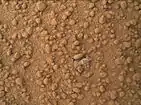












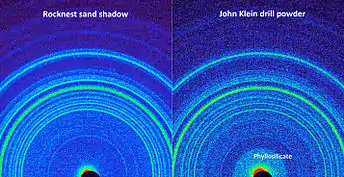

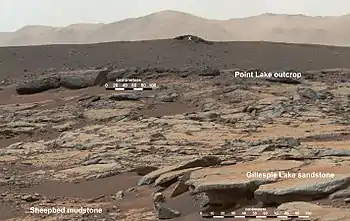


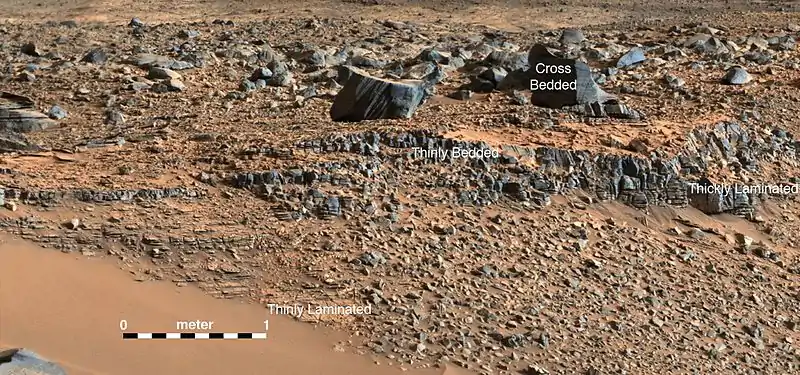

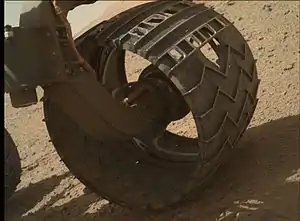



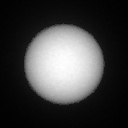
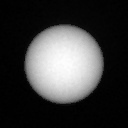





















.jpg.webp)
.jpg.webp)
